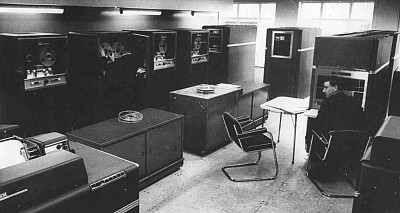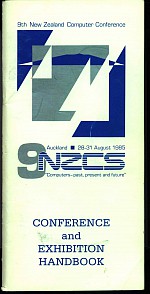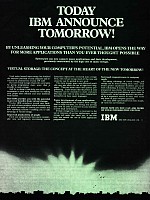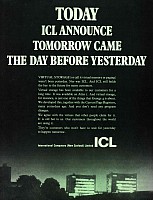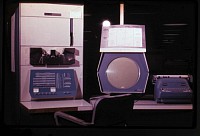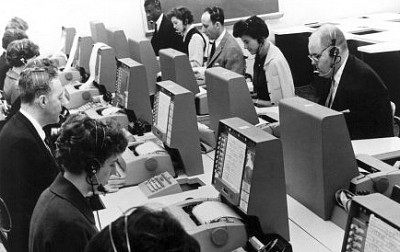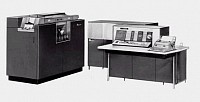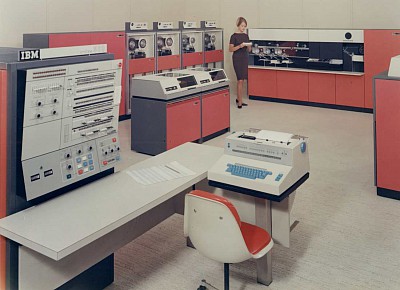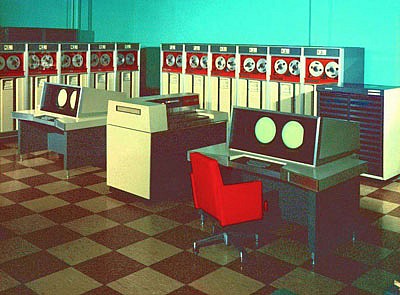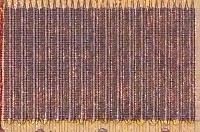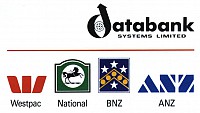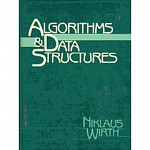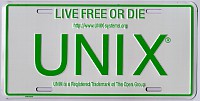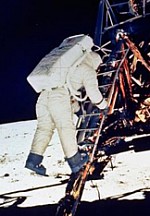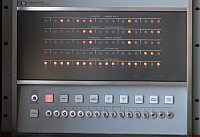Computer Science
Computing History Displays: Computer History Time Line - The age of IBM
The computing industry grew rapidly, building on 1950s technology which had improved considerably but not changed fundamentally. Software development became the main focus. Remote access to computers using telephone lines became common. Smaller cheaper computers, particularly those used for controlling machines, became available. Sales of computer hardware and software were dominated by IBM - the other major companies Burroughs, Univac, NCR, Control Data, and Honeywell were known as the BUNCH.
The IBM 650, which starts up in 1961, is the first computer in New Zealand. Installed at Treasury to automate the government payroll, it is old technology - it uses valve circuits and a rotating drum main memory, first introduced in 1954 - but the 650 widely replaces punch card data processing equipment and is a major industry workhorse world-wide. The photo below (courtesy New Zealand National Library) is of the 650 at Wellington in final testing. Further Images.
In 1960 the New Zealand Computer Society is established. Initially called the "Data Processing and Computer Society", it changes its name in 1968. The society has 200 members by 1965 and runs national conferences from 1968, allowing members to exchange ideas and see exhibitions of recent developments. Further Images.
As it becomes clear that there is an advantage in having computer systems that interleave the execution of multiple programs, it becomes desirable to ensure that programs do not deal with hardware resources directly. In 1961 the Ferranti Atlas introduces the concept of "virtual memory" which allows programs to be stored anywhere in computer memories and located automatically, regardless of the addresses used in the programs. Other computers, such as those from Burroughs, have different techniques to achieve the same goal. Virtual memory comes to IBM mainframes in 1975 and PCs with the 80486 in 1989. Further Images.
Sharing computing power among multiple users simultaneously - using the computer's speed to give the user the impression of sole control - helps spread the high cost of computers. Following the suggestion of John McCarthy, the first time-sharing system is developed in 1962 for the PDP1 computer manufactured by Digital Equipment Corporation (DEC.) The PDP1 computer is even better known as the computer for which the first video game - Space Wars - was developed by Steve Russell. One of the most important developments in time sharing in the 1960s was IBM's VM or CP/CMS time sharing operating system for their System/360 computers. This introduced the idea that the computer, as well as its memory, should be virtual - a concept that has found continued applicability up to the present day. Further Images.
The SABRE airline reservation system, developed in 1962 by American Airlines, is the first large-scale transaction processing system. It uses a large, expensive central computer whose database is accessed remotely by phone lines. Users sit at inexpensive terminals with text on screens or even using teletypes. The computer's role is reduced to that of a server.
4.2.7 University computers
The University of Auckland and the University of Canterbury install IBM 1620 computers in 1963. Victoria installs an Elliot 503 a short while later in co-operation with the Applied Mathematics Division of the Department of Scientific and Industrial Research (now Industrial Research Ltd). The 1620 is designed to be relatively inexpensive, but it is also very slow. The Auckland 1620 is on display on our first floor - you can read more here.
4.2.8 All-encompassing architecture
IBM's 360 range, which featured computers of various speeds and prices all having the same architecture, is a major conceptual step in 1964. The instruction set architecture is designed to be independent of the model of machine (programs written in 1965 can still be run on IBM servers). Now, a computer system is a range of software services which the hardware supports. With OS360, the modern operating system comes of age. You can read more about the System/360 in the displays on our 4th floor.
Computer bureaus that provide computing power to serve multiple users arrive in New Zealand in 1964. In Wellington, Denis Trotman founds Computer Services Ltd., in September, and offers services using IBM computers. CSL grew to operate in the three main centres in New Zealand until closing in 1987. Meanwhile, in Christchurch, a group originating in accounting firms orders an ICT 1902 computer which will be used by Computer Bureau Ltd. (CBL) founded by Bernard Battersby and Paul Hargreaves in July 1965. CBL later changes its name to Datacom and grows to be New Zealand's largest homegrown IT company, employing over 2500 people here, in Australia and Asia. Further Images.
The CDC 6600, designed by Seymour Cray, was the first "super computer". When introduced in 1964, the 6600 with its 10MHz clock, is by far the most powerful computer available for Scientific Computing. Further Images.
4.2.12 Computers - you can bank on them
In 1967, New Zealand banks decide to computerize data processing in time for the introduction of decimal currency. They set up Databank, an independent company, to do the job under the initial leadership of CEO Gordon Hogg. Databank grows to operate the largest computer centres in New Zealand. It is able to ensure that any cheque written on any NZ bank will be processed within 24 hours. This co-operation between banks will make for fast introduction of ATMs and EFTPOS in the 1980s. Databank is later taken over by EDS. Further Images.
The main aid to programming at this time is the flow chart. The use of flow chart design coupled with the ability to transfer control anywhere within a program results in programs that are hard to debug and maintain. Dijkstra's 1968 letter draws attention to the need to give more attention to the structure of programs, leading to the techniques of structured programming. In 1970 the Pascal Language is developed by Niklaus Wirth and intended for educational purposes, in fact remaining the main educational language for 25 years. The simple unstructured language Basic is also developed for educational use at Dartmouth College in 1966 by John G. Kemeny and Thomas E. Kurtz.
Digital Equipment Corporation's PDP11 is a very successful computer range whose architecture is developed at Carnegie-Mellon University. It is very easy to program at the machine language level and will expand into a line of computers that will last more than a decade and be very popular in universities, including this one. In 1969 staff at Bell Telephone Labs in the US develop their own programming language C and their own Operating System called Unix for Digital's minicomputers. Unix flourishes on the PDP11 and will be used on many different systems over the years and is now represented on PCs as Linux. C became a major language for software development.
4.2.16 Small is beautiful
The first departmental mini-computer at the University of Auckland is the Hewlett-Packard 2116 installed in 1969. Mini computers are small, relatively inexpensive computers designed for individual use as machine controllers or departmental computers. One of the most well-known is the PDP-8 of 1965, examples of which are used at Auckland University. The HP2116 is used for controlling our Physics Department's van de Graaf accelerator located on this site.
Top

